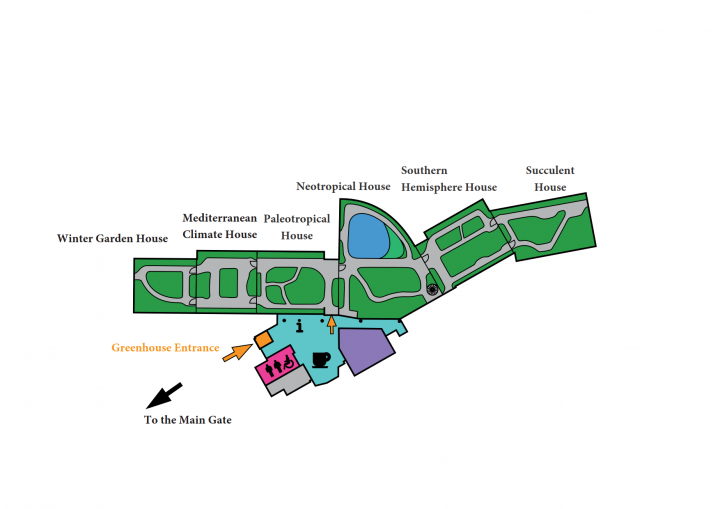Greenhouses
 The six greenhouses at the Botanical Garden contain approximately 2000 plant species or cultivars. You’ll see both exotic rareties and familiar house plants.
The six greenhouses at the Botanical Garden contain approximately 2000 plant species or cultivars. You’ll see both exotic rareties and familiar house plants.
In the Mediterranean Climate House you’ll find citrus fruits, with the grapefruit in particular producing large amounts of fruit. The Neotropical House has giant water lilies that flower overnight, with leaves over a metre in diameter. Tame cockatiels and budgerigars fly in the house, and large Koi carps and smaller fish such as angelfish and other cichlids inhabit the water. The Garden’s rainforests also include bright red flowering chenille plants, and in the Southern Hemisphere House you’ll meet a young Cretaceous pterosaur.
Southern Hemisphere House
The house mainly has southern hemisphere subtropical plants. These include living fossils, such as tree ferns and cycads, which were dominant around 200 million years ago during the Age of the Dinosaurs. A young pterodactyl hovers near the ceiling as a reminder of this.
Eucalyptuses, Casuarina trees and leaf cacti also inhabit the house. Several savanna Acacias display their impressive thorns.
Succulent House
The Succulent House has American cacti and African and Asian desert plants such as euphorbias and aloes. A long table stretching along the glass wall displays small cacti and other succulents such as carrion flowers (Stapelia). The plant in the central bed, in the genus Commiphora, is the species from which myrrh is extracted.
In the centre of the house there are several endemic cactus-like succulents from Madagascar. Many are endangered and belong to the uncommon Didiereaceae family.
The diversity of forms displayed by cacti is visible at rear of the house, with spherical cacti (called “anopinjakkara”, mother-in-law’s chair, in Finnish), tree-like cacti and forms that creep along the ground. In the unusal leaf cactuses (Pereskia), not all leaves have become spines, although the “leaves” are actually flat sections of the stem.
Winter Garden House
In the Winter Garden House the winter temperatures are only 8-10°C, to prevent cold-adapted species from dropping their flower buds. Such plants include camellias (Camellia japonica) and yellow-flowered winter jasmines (Jasminum nudiflorum).
The house is the most colourful part of the Botanical Garden in spring, when the rockflowers (Cistus) open their frail flowers. Cyclamens, velvetleaves of varying colours (Abutilon), angel’s trumpets (Brugmansia) and cestrums (Cestrum) also flower in spring.
You’ll also find familiar spices such as rosemary (Rosmarinus officinalis) here. In March the flamevine (Pyrostegia venusta), growing near the highest point of the roof, produces its beatiful flowers.
Conifers include the redwood (Sequoia sempervirens) which can grow up to 130 metres tall. There are several carnivorous plants including sundews (Drosera), butterworts (Pinguicula) and pitcher plants (Sarracenia).
Neotropical House
The largest of the houses contains American rainforest plants. The pond with its giant water lilies (Victoria) immediately catches the eye. Many other plants also inhabit the pond, including the common water hyacinth (Eichhornia crassipes) and Nile cabbage (Pistia stratiotes).
Insect eating Asian pitcher plants (Nepenthes) dangle from the branches by the pond. Their leaves have formed into a trap for insects: insects fall into the pitcher and are dissolved and digested by the enzyme-rich liquid in a matter of days. There are also many plants used by humans such as sugar cane, tamarillo and banana.
Epiphytes such as ferns, orchids and bromeliads are common in the house. The spanish moss (Tillandsia usneoides) is perhaps among the most unusual in appearance.
Paleotropical House
Most of the plants in the Paleotropical House are from tropical Asia and Africa. Many of them are useful to humans, including coffee (Coffea), pepper (Piper), cinnamon (Cinnamomum zeylanicum), camphor (Cinnamomum camphora) and mango (Mangifera indica). Manila hemp (Musa textilis) belongs to the same genus as bananas and gives a very strong natural fibre.
Some of the lushest vegetation in the house consists of several different fig species. Some of the species produce adventitious roots, which can entwine and slowly strangle neighbouring trees to death.
The Paleotropical House also contains one of the most primitive vascular plants, the whisk fern (Psilotum). Climbing figs (Ficus pumila) climb one of the walls and elkhorn ferns (Platycerium) live as epiphytes in the canopy.
Mediterranean Climate House
Oleanders, pomegranates, pepper trees, geraniums, calla lilies and many other plants flower in the Mediterranean climate. St. John’s Bread (Ceratonia siliqua) also grows in the house.
The Brazilian Bougainvillea, with their multicoloured bracts, are almost bursting through the greenhouse roof. Some of the taller potted plants in the house spend their summers outdoors.

